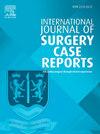Charcot-Marie-Tooth病全膝关节翻修置换术1例报告
IF 0.7
Q4 SURGERY
引用次数: 0
摘要
CMT病是一种罕见的遗传性神经病变,以进行性远端肌无力和步态生物力学改变为特征。全膝关节置换术(TKA)在CMT患者中可能具有挑战性,因为对长期结果知之甚少。该病例强调了对行TKA的CMT患者进行术前计划和有组织的随访的必要性,因为松动可能发生在早期阶段。病例介绍一名72岁晚期CMT患者,原发TKA术后10年出现致残性疼痛和多向不稳定。x线检查显示严重的无菌性松动和广泛的干骺端骨丢失。翻修手术采用一期入路,使用旋转铰链TKA和胫骨干骺端增强。患者恢复良好,功能得到改善。旋转铰链TKA的一期翻修在3年后显示出良好的结果。CMT患者可能表现为多平面关节不稳定和步态异常,对标准髁植入物施加更大的压力并加速松动。在这种情况下,标准的植入物可能不合适。早期考虑有茎或有约束的种植体可以提高稳定性和耐久性。翻修手术可能会因骨质流失和不稳定而进一步复杂化,因此需要使用旋转铰链TKA系统。密切的术后监测对于早期发现这些高危人群的并发症至关重要。结论cmt相关的神经肌肉功能障碍可能导致TKA早期衰竭。这个病例强调了术前计划和长期随访的重要性。当出现严重的骨质流失和不稳定时,对旋转铰链TKA的修正提供了可靠和持久的解决方案。本文章由计算机程序翻译,如有差异,请以英文原文为准。
Revision total knee arthroplasty with Charcot-Marie-Tooth disease - a case report
Introduction and importance
Charcot-Marie-Tooth (CMT) disease is a rare hereditary neuropathy characterized by progressive distal muscle weakness and altered gait biomechanics. Total knee arthroplasty (TKA) in CMT patients can be challenging, as little is known about long-term outcomes. This case highlights the need for pre-operative planning and structured follow-up of patients with CMT who underwent TKA, as loosening might occur at an early stage.
Case presentation
A 72-year-old woman with advanced CMT disease presented with disabling pain and multidirectional instability ten years after a primary TKA. Radiographic evaluation revealed severe aseptic loosening and extensive metaphyseal bone loss. Revision surgery was performed in a one-stage approach using a rotating-hinge TKA with tibial metaphyseal augmentation. The patient experienced excellent recovery and functional improvement. One-stage revision to a rotating-hinge TKA demonstrated a favourable outcome at 3 years.
Clinical discussion
Patients with CMT may present with multiplanar joint instability and abnormal gait, placing increased stress on standard condylar implants and accelerating loosening. In such cases, standard implants may not be appropriate. Early consideration of stemmed or constrained implants may improve stability and durability. Revision surgery may be further complicated by bone loss and instability, warranting the use of rotating-hinged TKA systems. Close postoperative monitoring is critical to detect complications early in this high-risk population.
Conclusion
CMT-related neuromuscular dysfunction may predispose to early TKA failure. This case underlines the importance of preoperative planning and long-term follow-up. When major bone loss and instability are present, revision to a rotating-hinged TKA offers a reliable and durable solution.
求助全文
通过发布文献求助,成功后即可免费获取论文全文。
去求助
来源期刊
CiteScore
1.10
自引率
0.00%
发文量
1116
审稿时长
46 days

 求助内容:
求助内容: 应助结果提醒方式:
应助结果提醒方式:


